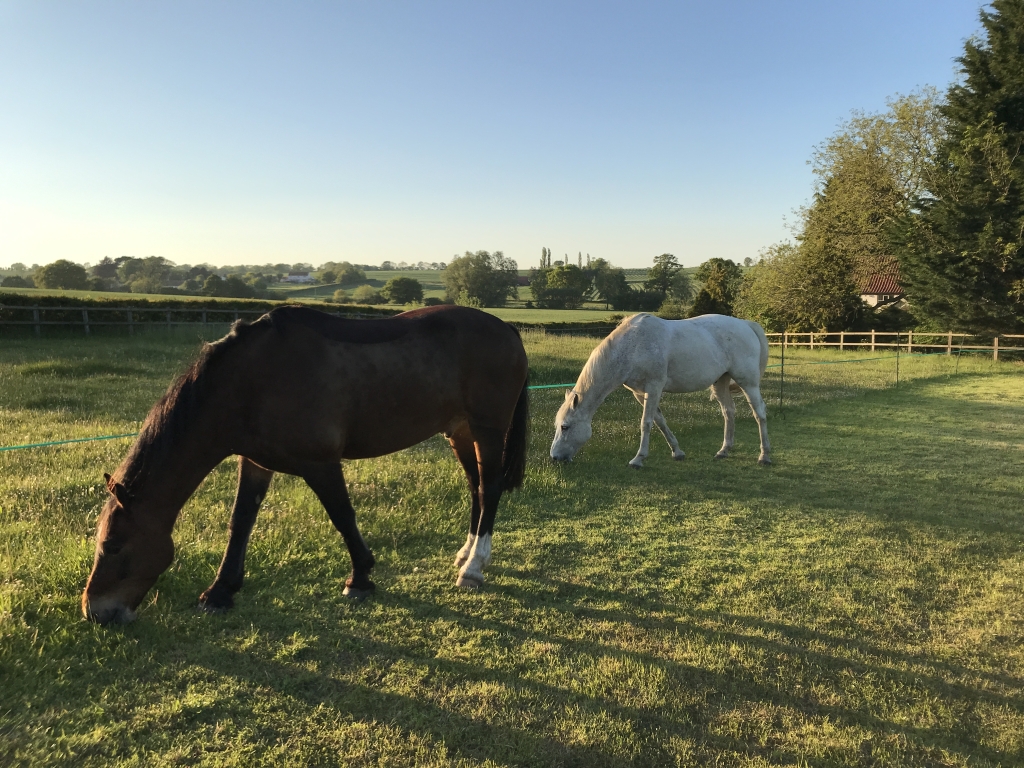
Strip Grazing Delivers A Steadier Supply Of Nutrients Than Free Grazing
A newly published study has shown that after rapid spring grass growth has stopped, strip grazing can deliver a steadier nutrient supply to horses than when they have free access to restricted grazing. This sheds further light on why strip grazing may be an effective weight management tool.
A previous study conducted in association with the SPILLERS™ brand1 has already shown that strip grazing can be an effective way of restricting grass intake to help manage the bodyweight of pastured ponies, although the reasons for this were not elucidated. This follow-up research highlights the advantages of consistent nutrient intake that may be offered by strip grazing.
Strip-grazing refers to the gradual release of limited amounts of fresh herbage within a pasture to animals via a moveable fence. The new work Strip grazing: Changes in biomass, nutrient content and digestibility of temperate, midsummer pasture by strip-grazed or ‘free’-grazing ponies, over 4 weeks2 was conducted, in collaboration with the SPILLERS brand, and the WALTHAM™ Equine Studies Group, by Dr Annette Longland of Equine Livestock and Nutrition Services.
Twelve ponies were individually grazed in long, narrow paddocks, designed to yield herbage equivalent to 1.5% (dry matter) of the ponies’ bodyweight per day for 28 days from late June to late July, once the early, very rapid, spring growth had finished. For the first two days, all ponies were grazed on mown ‘start paddocks’ after which they were assigned to one of three grazing practices for the remainder of the study: no other restriction (total allowance; TA group), or one of two strip grazing groups where either a lead fence was placed across the width of the paddock which was moved an equal distance each day to allow fresh grass to be accessed or strip grazed with both a lead and a back fence with the back fence being moved the same distance as the lead fence daily. Pasture nutrient contents and estimated nutrient digestibilities were evaluated on a weekly basis.
The results showed that strip-grazing delivered herbage of more consistent nutritive quality over the course of the trial compared to when the ponies had free access to the same amount of original herbage. The findings also reiterated the potential value of strip-grazing as an effective tool for weight management.
The start paddocks remained leafy and green throughout the study while the nutritive value of the remaining grass declined with increasing maturity as is typically expected for mixed species pastures in the UK. Importantly, strip grazing prevented the aggressive selective grazing seen in the total allowance (TA) group, where the ponies depleted the more nutritious herbage in the first half of the study, leaving the more mature, less nutritious herbage for consumption in the second half.
As a result, the calculated digestible energy intakes of the TA ponies in weeks one and two exceeded requirements by 42 % vs. 8 % by the strip-grazed ponies. Over the course of the study, the TA ponies gained three-four times more weight than their strip-grazed counterparts, with over 70% of the TA ponies’ weight gain occurring in the first two weeks. In contrast, strip grazed ponies gained significantly less weight overall at a more consistent rate.
“This study gives us some important practical take home messages regarding weight management and potentially the management of associated disorders such as insulin dysregulation and laminitis,” said Sarah Nelson, Product Manager at Mars Horsecare, home of the SPILLERS brand.
“Strip grazing in this study prevented rapid weight gains by providing gradual access to fresh pasture of decreasing nutrient value and preventing aggressive selective grazing. This work shows how strip grazing, if carried out appropriately, can be an effective weight management tool especially once the very rapid, spring growth is over. However, it is important to remember that even strip grazing on high non-structural carbohydrate (NSC) containing pastures may not be suitable for some laminitis prone equids, especially those that are at high risk or at certain times of year.”
For further advice on managing such individuals contact the SPILLERS Care-Line.
To find out more about the SPILLERS range contact the Care-Line on + 44 (0)1908 226626 or visit www.spillers-feeds.com.
ENDS
References
1 Longland, AC, Barfoot, C, Harris, PA. Strip-grazing: Reduces pony dry matter intakes and changes in bodyweight and morphometrics. Equine Vet J. 2021; 00: 1– 8. https://doi.org/10.1111/evj.13416
2 Longland, AC, Barfoot, C, Harris, PA. Strip grazing: Changes in biomass, nutrient content and digestibility of temperate, midsummer pasture by strip-grazed or ‘free’-grazing ponies, over 4 weeks. https://www.sciencedirect.com/science/article/abs/pii/S0737080623007736
More from Spillers
- Feed brand invites horse owners to ‘Play Your Calories Right’ and win £250
- Feed manufacturer’s survey uncovers equine weight management obstacles
- Feed brand to donate to Redwings for every new Club member
- Win fame and free feed with leading equine nutrition brand
- Mars Horsecare appoints new Global Science & Nutrition Director

 2 years ago
2 years ago  2271 views
2271 views